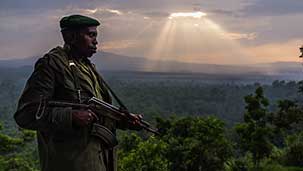At the risk of sounding ungracious, your work on Virunga hurt my enjoyment of the film. Not because it was sub-par. Quite the opposite. The fact is, the sonic gloss you applied to Orland von Einsiedel’s documentary was so perfectly polished that it seemed at times to work against the very nature of the film and its intentions.
Your imprint is everywhere. From slow-motion shots of water droplets to ear-ringing gun shots and bombs, your hyper-realistic sound effects actually disengaged me from the material—albeit subconsciously. I felt like I was watching a Hollywood film. That says a lot, considering my ongoing relationship with East Africa.
I’ve had the privilege of visiting the volcanic Virunga region of the Democratic Republic of Congo, and even spent time at Dian Fossey’s Gorilla Rehabilitation and Conservation Education (GRACE) center. Much of Virunga plays out there, telling the story of a similar gorilla orphanage and the rangers tasked with protecting the surrounding national park.
And by protecting, I do mean with AK-47s.
I understand firsthand the shock of seeing soldiers brandish their weapons so freely— and I understand the temptation to play that up. I’m guilty of the same dramatics when I recount my experiences travelling with mountain trackers and guides who are armed with guns to protect us not from the gorillas, but from the guerillas.
Which is no doubt why the director indulges in a few dramatic point-of-view shots down the barrel of a gun. In that sense, your work is only complimenting his vision. Which isn’t entirely unjustified. The DRC is a ridiculously dangerous place. More people have been killed in the Congolese Civil War than in any other conflict since WWII. So when the story of Virunga quickly turns from being that of a safari to surviving an armed take-over by M23 rebels, I know why you went full-clip on the sound effects. A simple shaky camera (in huge contrast to the film’s otherwise beautiful cinematography) is energized tenfold by the overwhelming echo of shelling and gunshots. But by laying that continuous sound bed over so many cuts, the danger felt almost manufactured. I felt manipulated, like you were trying to give me what you think I wanted.
It’s not so different from my experience with the gorillas themselves. With only 800 in the world, seeing a majestic Silverback in the wild has truly been one of the highlights of my life. In contrast, seeing a baby gorilla in one of those concrete rehab centers was one of the most depressing. It’s hard to articulate the profound nature of that difference, but it repeatedly came to mind watching the film.
The good news is, while I’m spending a disproportionate amount of time fixating on your amplification of the drama, real drama does occur in this film. I hope that more people spend the money to visit these parks and support their preservation. I just hope you haven’t scared them away (I guess we’ll just have to remind them that entering the park from the Rwandan and Ugandan side is much, much safer).
Turning it down a notch.
Christopher







